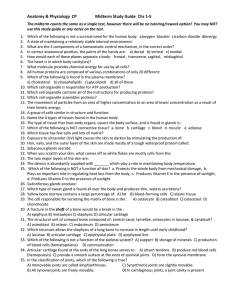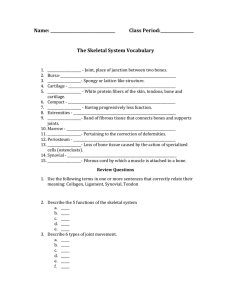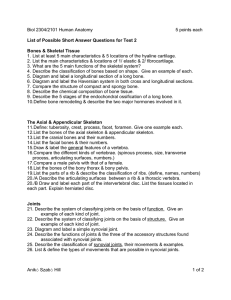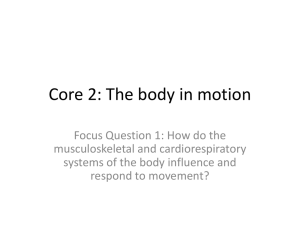JOINTS Joint Functions: • mobility
advertisement
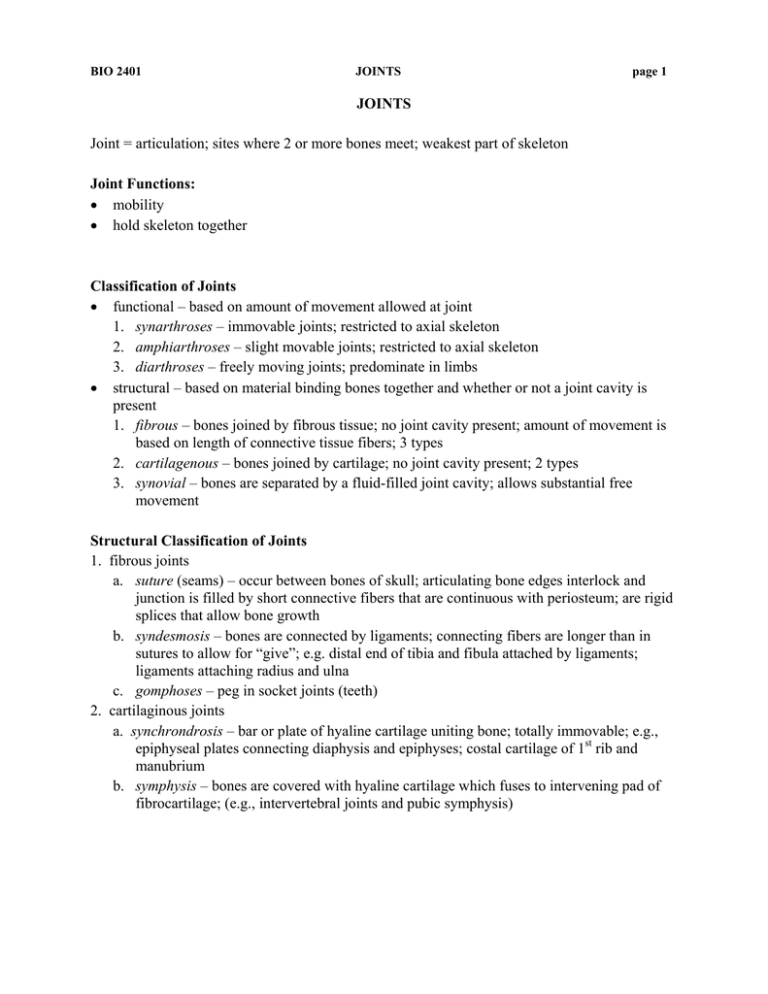
BIO 2401 JOINTS page 1 JOINTS Joint = articulation; sites where 2 or more bones meet; weakest part of skeleton Joint Functions: • mobility • hold skeleton together Classification of Joints • functional – based on amount of movement allowed at joint 1. synarthroses – immovable joints; restricted to axial skeleton 2. amphiarthroses – slight movable joints; restricted to axial skeleton 3. diarthroses – freely moving joints; predominate in limbs • structural – based on material binding bones together and whether or not a joint cavity is present 1. fibrous – bones joined by fibrous tissue; no joint cavity present; amount of movement is based on length of connective tissue fibers; 3 types 2. cartilagenous – bones joined by cartilage; no joint cavity present; 2 types 3. synovial – bones are separated by a fluid-filled joint cavity; allows substantial free movement Structural Classification of Joints 1. fibrous joints a. suture (seams) – occur between bones of skull; articulating bone edges interlock and junction is filled by short connective fibers that are continuous with periosteum; are rigid splices that allow bone growth b. syndesmosis – bones are connected by ligaments; connecting fibers are longer than in sutures to allow for “give”; e.g. distal end of tibia and fibula attached by ligaments; ligaments attaching radius and ulna c. gomphoses – peg in socket joints (teeth) 2. cartilaginous joints a. synchrondrosis – bar or plate of hyaline cartilage uniting bone; totally immovable; e.g., epiphyseal plates connecting diaphysis and epiphyses; costal cartilage of 1st rib and manubrium b. symphysis – bones are covered with hyaline cartilage which fuses to intervening pad of fibrocartilage; (e.g., intervertebral joints and pubic symphysis) BIO 2401 JOINTS page 2 3. synovial joints – articulating bones are separated by fluid-filled cavity; e.g., all joints in limbs; 4 structures common to all synovial joints 1) articular cartilage (hyaline) – is spongy; absorbs compression placed on joint; thus keeps bones from being crushed at their ends 2) joint (synovial) cavity – filled with synovial fluid 3) articular capsule – 2 layered; external layer is tough fibrous capsule (dense irregular tissue) and is continuous with periostea of articulating bones; internal layer is a synovial membrane (loose connective tissue) 4) synovial fluid – filtrate of blood that is viscous (becomes less viscous with joint activity because fluid is warmed up); provides slippery weight-bearing film that reduces friction between cartilages; is forced from cartilages when joint is compressed and seeps back as pressure is released; contains phagocytic cells that clean up cellular debris 5) other structures found in many synovial joints: • reinforcing ligaments – reinforces and strengthens; can be intrinsic (part of fibrous capsule) or extracapsular; can also be intracapsular and covered with synovial membrane • bursae – flattened fibrous sacs lined with synovial membrane; contain a thin film synovial fluid; common in sites where ligaments, muscles, skin, tendons or bones rub together • tendon sheath – elongated bursae that wraps completely around a tendon subjected to friction Types of Movement in Synovial Joints 1. gliding – simplest movement; one flat bone surface glides over another similar surface (e.g., intercarpal and intertarsal joints; articular processes of vertebrae) 2. flexion – bending movement; decreases angle of joint and brings bones close together usually over a sagittal plane (e.g., bending knee or body trunk; bending head forward on chest) 3. extension – reverse of flexion; increases angle between articulating bones; can hyperextend (bending back beyond upright position) 4. abduction – movement of a limb away from midline, along frontal plane (e.g., raising arm or thigh laterally, or spreading toes) 5. adduction – opposite of abduction; movement of a limb toward body midline 6. circumduction – moving a limb so it describes a cone in space; distal end moves in circle while point of cone (proximal end) remains stationary; consists of flexion, abduction, extension, and adduction performed in succession 7. rotation – turning of a bone around its long axis; can be medial or lateral (e.g., movement between first 2 cervical vertebrae and at hip and shoulder joints) 8. supination – refers to movements of the radius around the ulna; ulna and radius are parallel to each other (defines anatomical position) 9. pronation – refers to movement of the radius around the ulna; radius is rotated over ulna; weaker movement than supination (is position when palm faces downward or posteriorly) BIO 2401 10. 11. 12. 13. 14. 15. 16. JOINTS page 3 inversion – special movement of foot; sole of foot turns medially eversion – special movement of foot; sole of foot turns laterally protraction – nonangular anterior movement in a transverse plane (e.g., jutting out of jaw) retraction – nonangular posterior movement in a transverse plane (e.g., moving jaw back to original position after jutting it out) elevation – lifting a body part superiorly (e.g., chewing) depression – moving an elevated body part inferiorly (e.g., chewing) opposition – thumb only; results because of saddle joint between metacarpal 1 and carpals Types of Synovial Joints – 6 major categories 1. plane – articulating surfaces are flat; allow only short slipping or gliding movements; nonaxial joints (e.g., joints between vertebral articular processes and intercarpal/intertarsal joints) 2. hinge – motion is along a single plane, like a hinge; occurs when a cylindrical projection of 1 bone fits into a trough-shaped surface on another bone; permits flexion and extension only (e.g., bending and straightening elbow and interpharyngeal joints) 3. pivot – movement is uniaxial rotation of one bone around its own long axis; occurs when rounded end of one bone protrudes into a sleeve or ring of another (e.g., joint between atlas and dens of axis; rotation of radius around ulna at proximal end) 4. condyloid – ellipsoidal joint; oval articular surface of one bone fits into complementary depression in another; both articular surfaces are oval; permits all angular motions (flexion, extension, abduction, adduction) (e.g., metacarpophalangeal or knuckle joint; radiocarpal or wrist joint) 5. saddle – each articular surface has both concave and convex areas; articular surfaces fit together, concave to convex surfaces (e.g., carpometacarpal joints of thumb; allows twiddling of thumbs) 6. ball and socket – spherical or hemispherical head of one bone articulates with cuplike socket of another; most freely moving joints in all axes and planes, including rotation (e.g., shoulder and hip joints) Joint Disorders 1. bursitis – inflammation of a bursa (excessive fluid accumulates); usually caused by a blow or friction 2. sprain – ligaments reinforcing joint are stretched or torn; heal slowly because ligaments are poorly vascularized 3. arthritis – 100 different types of inflammatory or degenerative diseases that damage the joints; symptoms are pain, stiffness, and swelling • osteoarthritis – chronic; wear and tear arthritis; course is slow and irreversible; theory is that normal joint use prompts release of enzymes that break down articular cartilage, but more cartilage is destroyed than replaced; get softened, roughened, cracked and eroded cartilages and bone tissue thickens and forms bony spurs that may restrict joint movement BIO 2401 • • JOINTS page 4 rheumatoid arthritis – chronic inflammatory disorder; early stages include joint tenderness and stiffness; get flare-ups and remisions; is an autoimmune disorder where the synovial membrane becomes inflammed and inflammatory cells migrate into joint cavity from blood; synovial fluid accumulates, swelling joint; inflamed membrane thickens into a pannus and this erodes the cartilage; scar tissue forms and attaches to bone ends, eventually ossifying and immobilizing the joint gout – uric acid gets deposited as needle-shaped crystals in soft tissue of joints; causes inflammatory response and great pain; can result in fusion of articulating bones


